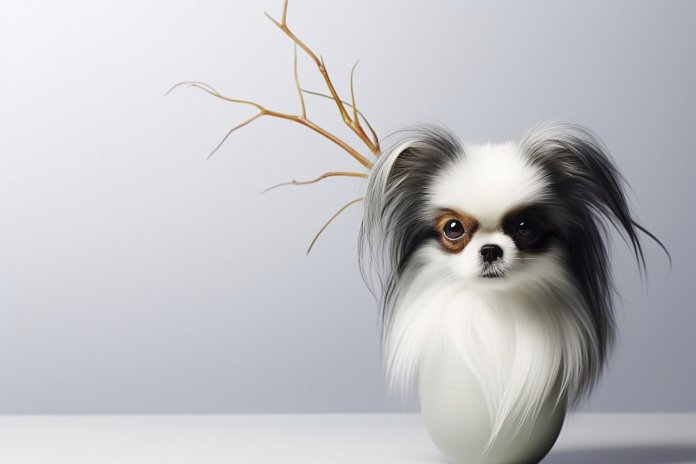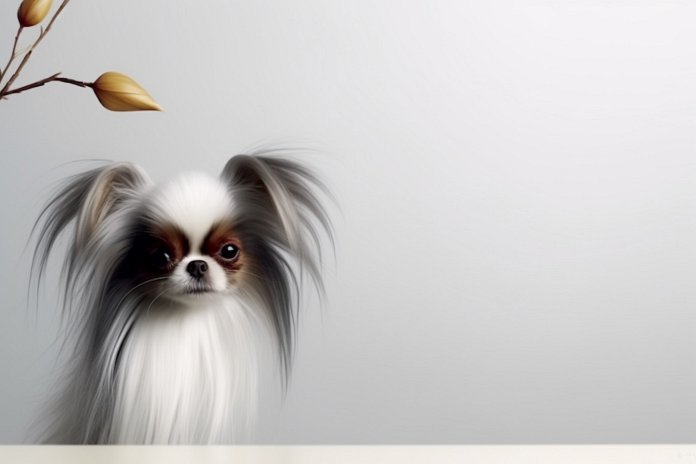
A Chinaranian is a hybrid breed that results from the combination of a Chinese Crested and a Pomeranian. These dogs come in various colors, including shades of brown, black, cream, blue, or grey. The texture of their coat can be either thick or fine, and it is usually short. However, regardless of their coat type, regular grooming is necessary to keep the Chinaranian looking its best.
The Chinaranian, also known as a Crested Pom, is a small and affectionate dog that typically weighs up to 10 pounds. Despite their small size, they require regular exercise to stay in good shape. While they are generally good with older children, families with very small kids should exercise caution as they could accidentally harm the Chinaranian due to its delicate nature.
Ahead, we look at Chinaranian dog breed, its history, personality, pros and cons of owning an Chinaranian, characteristics, and must-see facts. We will also examine how to care for this breed and a lot more. Prepare for a tail-wagging adventure into the world of Chinaranians!
| Dog Breed | Chinaranian |
| Size | Small |
| Weight | 8-9 lbs (average) |
| Height | 7-11″ (average) |
| Location | United States |
| Ancestry | Chinese Crested, Pomeranian |
| Date of Origin | Unknown |
| Group | Companion |
| Life Expectancy | 12-16 years |
| Price | $800 – $1000 |
| Family | Canidae |
| Scientific Name | Canis Lupus Familiaris |
📖 Breed History
The Chinaranian, a mix of the Chinese Crested and Pomeranian breeds, is a small and intelligent dog that belongs to the Spitz family. Throughout history, notable figures such as theologian Martin Luther, artist Michelangelo, physicist Isaac Newton, and composer Mozart have owned these feisty dogs. The name “Pomeranian” comes from the Pomerania region in Germany and Poland, where they were believed to have been bred to a smaller size. British royalty, including Queen Victoria, were also fond of the breed and bred smaller varieties of Pomeranians. In fact, it is said that Queen Victoria requested her favorite Pom named Turi to be by her side on her deathbed. The American Kennel Club (AKC) officially recognized the breed in 1900, even though the first Pom, named Dick, was entered into the AKC stud book in 1888.
It’s important to note that Chinese Crested dogs do not originate from China. They come in two varieties: Hairless and Powderpuff. The Hairless variety is dominant in these dogs. There is a possibility that they are related to the African Hairless Dog or the Mexican Hairless Dog, also known as the Xoloitzcuintli. This suggests that their origins may lie in Africa or Mexico. The American Hairless Dog Club was established in 1959 by Debra Wood. The Chinese Crested breed was officially recognized by the Kennel Club in the United Kingdom in 1981 and was later added to the roster of the American Kennel Club in 1991.

🐕 Chinaranian Appearance
Small canines that may weigh up to 10 pounds, Chinaranian dogs can vary depending on which of their parent breeds is more prevalent. The coats are often short, can be thick and fine, and are typically colored brown, black, cream, blue, or grey. In contrast to the Chinese Crested, whose body is coated in long, silky fur, Pomeranians may be extremely fluffy dogs. Pom has upright ears on top of their heads and almond-shaped, dark-colored, brilliant eyes. The Chinese Crested also has rather big, upright ears and black, almond-shaped eyes. Your Chinaranian will undoubtedly have eyes that are prominently displayed on a face with an alert expression, since both of the parents have many comparable traits.
| 👀 Eye Color | Brown |
| 🐽 Nose Color | Black |
| 🐕 Coat Color | Pied, Gray, Blue, Cream, Black, Brown |
⚡ Fun Fact: Chinaranian dogs need a lot of social interaction. They desire to always be with someone or around people. This breed hates being left alone.
🐶 Traits & Temperament of Chinaranian
The Chinaranian is a lively, loving dog that would make a terrific family companion, ideally in a home with somewhat older kids. Although they can be trained, they are obedient and clever, so owners may need to be patient. The Chinaranian is expressive, inquisitive, and likes nothing more than to be the center of attention, much like its parent breeds. They detest being left alone for an extended period of time. Poms also respond well to owners who spend a lot of time with them, while the Chinese Crested is known to “hug” its owners with its paws to indicate affection. Despite being little dogs, they require a lot of activity, therefore a home with a fenced yard is ideal. If taken out for frequent exercise sessions, they could adjust to apartment living. As long as they are socialized from an early age, they will get along with other dogs.
🤝 Are Chinaranians Friendly or Aggressive?
Chinaranian dogs are known for their friendly nature and are considered one of the most amiable dog breeds. They tend to be fairly friendly towards strangers and are generally good with children. These dogs also have a positive relationship with cats, being very cat-friendly. While they are on average friendly towards other dogs, their behavior may vary depending on individual personality and socialization. Chinaranians also tend to get along well with elderly people, making them suitable companions for seniors.
This breed is known for being:
- Active
- Playful
- Happy
- Alert
- Intelligent
- Friendly
- Docile
- Affectionate
- Lively
- Tempered
- Sociable
- Sweet
- Attentive
- Trainable
- Extroverted
🐩 Chinaranian Care & Maintenance
To keep your pet looking well, regular grooming will be necessary, but a lot will depend on which parent breed it most closely resembles. If your pet has traits similar to a Powderpuff Chinese Crested, regular brushing will be necessary to keep it from matting. When going outside, the hairless variety has to use sunscreen and moisturizer on their skin. Additionally, they need routine bathing with a quality pet shampoo. Chinese Crested dogs are said to be hypoallergenic, making them suitable for those who suffer from allergies. Because of their luxurious coats and fox-like looks, Pomeranians require rather frequent maintenance to keep their fur from matting. Due to the small size of both parent breeds, dental problems are common, so make sure to brush your dog’s teeth every day or at least three times each week.
Chinaranian dogs are known for being low shedders, meaning they don’t lose a lot of hair. This is a natural part of their hair growth cycle. The amount and frequency of hair loss can vary depending on their overall health and the specific breed they belong to. In terms of bathing, Chinaranian dogs typically require a bath every 3-4 weeks.
🍖 Food: We recommend 1 cups daily, costing you about $0.80 – $1.00 daily, or roughly $25.00 – $30.00 a month.
🐾 Exercise: Chinaranian dogs exercise need is minimal. If you live a slow life, this breed can be a good choice for you.
This dog breed requires to be walked for roughly 8 miles per week, which equates to about 30 minutes of physical activity daily. This consistent moderate exercise regimen will help maintain their physical wellness and significantly contribute to their mental stimulation. Consciously setting aside this time for your furry friend can dramatically enhance their life quality, helping them stay energetic, healthy, and mentally alert.
Did you know: Chinaranian dogs have an average energy level, so if you live a semi-active life, this breed can be a good choice for you.
❤️🩹 Chinaranian Health & Issues
Some of the major concerns for Chinaranian Dog Breed can be:
- Progressive Retinal Atrophy
- Lens Luxation
While minor concerns include:
- Patellar Luxation
- Entropion
- Tracheal Collapse
🤧 Important: Is Chinaranian hypoallergenic? No.
✨ Bonus: Check out cool, creative, and funny names for Chinaranian.
⚡ Chinaranian Dog Breed Facts
What makes the Chinaranian a great choice for families with young children?
The Chinaranian is not considered a great choice for families with young children. While they are fine with older children, they are not recommended for families with very young children who might accidentally injure them.
Is the Chinaranian breed considered a suitable breed for apartment living?
The Chinaranian breed can adapt to apartment living as long as they are taken out regularly for exercise sessions. They are small dogs that require exercise, so having a fenced-in yard would be beneficial.
How much exercise does a Chinaranian require compared to other breeds?
The Chinaranian requires a moderate amount of exercise compared to some other breeds. They are small dogs, but they still need regular exercise to stay in shape.
Is the Chinaranian breed known for being good with other pets?
Chinaranians can get along well with other dogs as long as they are socialized at an early age.
What are other low-maintenance dog breeds similar to the Chinaranian?
Some low-maintenance dog breeds similar to the Chinaranian include the Chihuahua, Maltese, and Shih Tzu.
What are the common health issues that Chinaranians are prone to?
Common health issues that Chinaranians are prone to include dental problems, skin allergies, and luxating patella (knee joint dislocation).
Are Chinaranians known to be easy to train compared to other breeds?
Chinaranians can be trainable, but owners may need to have patience. They are loyal and intelligent dogs.
Are Chinaranians more prone to separation anxiety compared to other breeds?
Chinaranians are known to be prone to separation anxiety, just like their parent breeds. They don’t like being left alone for long periods of time.
Are there any dog breeds similar to the Chinaranian that are suitable for people with allergies?
Some dog breeds similar to the Chinaranian that are suitable for people with allergies include the Bichon Frise, Portuguese Water Dog, and Schnauzer.
What sizes of dogs similar to the Chinaranian are best for individuals or families with limited space?
For individuals or families with limited space, smaller dogs similar in size to the Chinaranian would be best. Examples include the Pomeranian, Maltese, and Shih Tzu.
Is the Chinaranian breed known to be good with children with special needs?
While the Chinaranian can be good with children, there is no specific information about their suitability for children with special needs. It would be best to consult with a breeder or behaviorist in such cases.
How does the grooming and shedding needs of the Chinaranian?
The grooming and shedding needs of the Chinaranian can vary depending on which parent breed the dog takes after. The coat is usually short and can be thick or fine. Regular grooming is necessary to keep them in shape and maintain their coat’s health. They may shed moderately.
We use reliable and publicly available data and resources such as AKC and American Canine Registry to ensure that Chinaranian dog breed information is accurate and up to date. If you spot an error, please don’t hesitate to bring it to our attention.